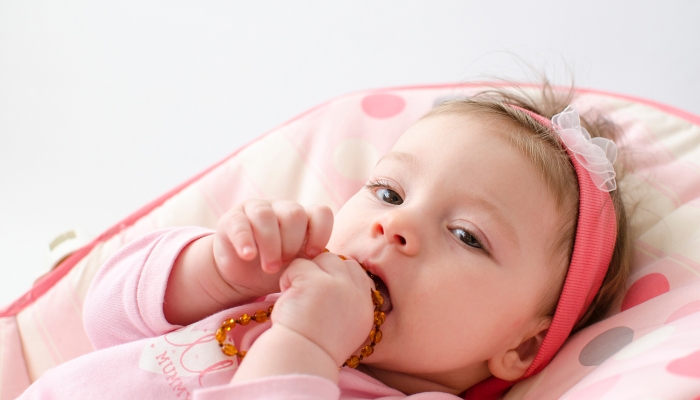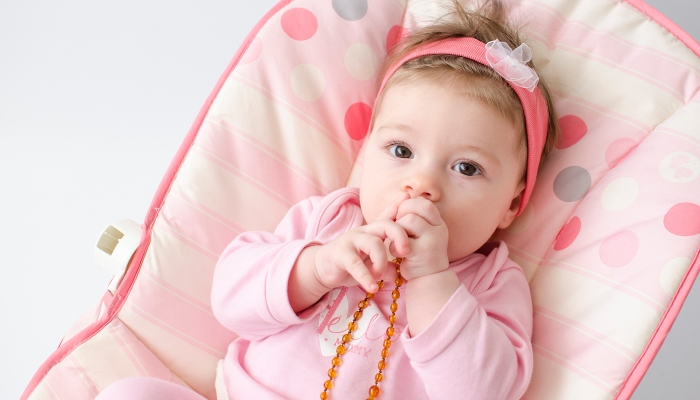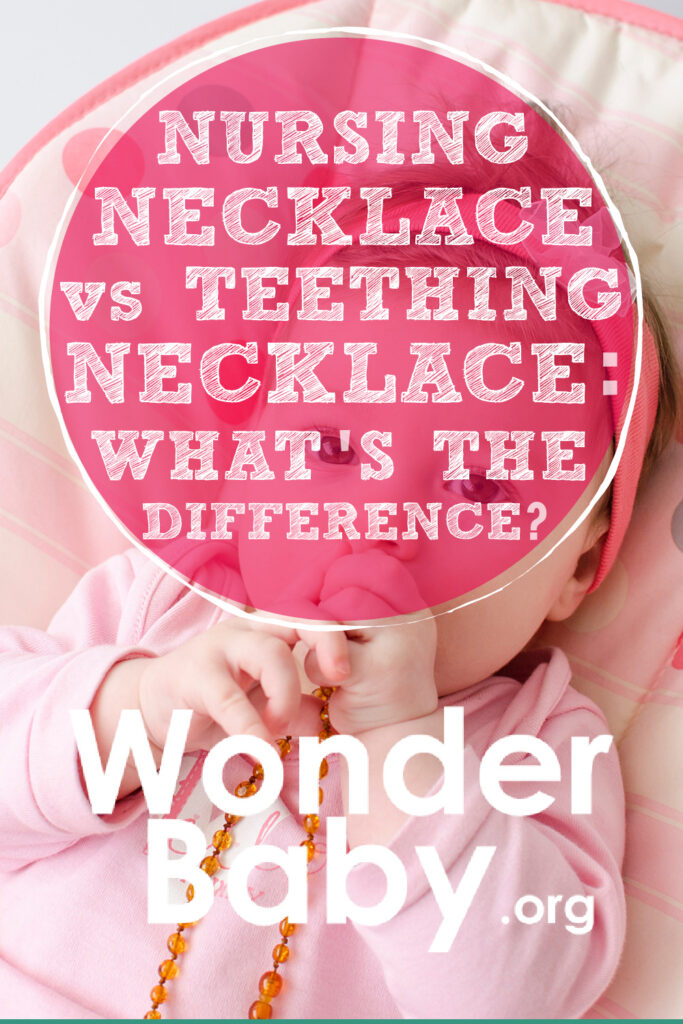Nursing Necklace vs Teething Necklace: What’s the Difference?

- Nursing necklaces are breastfeeding necklaces designed specifically to keep a baby focused on their mother as they breastfeed.
- A teething necklace is a necklace worn by a baby to help with teething pain.
- Only allow your baby to chew on a wooden or food-grade silicone teething necklace when it is around your own neck.
I’ve nursed four babies, thus far, in my motherhood journey. Through it all, I’ve learned so much, including how to handle a forceful letdown, how to treat a clogged milk duct, and how to open a drawer with my toes while holding a nursing baby. Yet there was always one nursing hurdle that stumped me—the distracted nursing stage.
You’ll know when your baby has hit this stage.
Normally, babies will stay focused while nursing until they have finished eating. When the age of distraction hits, they’ll continually unlatch and turn their head toward new sounds. It can be tiresome for the mom who just wants to finish the nursing session.
It wasn’t until baby number four that a friend introduced me to something called a nursing necklace. It was a game-changer for that difficult stage of nursing. However, every time I’d wear it, many people would ask me if it was a teething necklace.
I was honestly confused about the difference between the two. My baby could chew on the nursing necklace, but did that make it a teething necklace? And what were the necklaces I saw many babies wearing around their necks?
If you’re wondering the same question, you’re in the right place. We’ll break down the simple differences between a teething necklace and a nursing necklace. You’ll be able to confidently purchase the right necklace for your needs.
What is a Nursing Necklace?
A breastfeeding necklace is a fairly new item to the world of baby gear. At some point, innovators must have realized how enamored babies were with necklaces. However, normal necklaces are known to be dangerous for babies to play with.
This is when these brilliant innovators designed a necklace that a breastfeeding mom could safely wear around her neck. Nursing necklaces are breastfeeding necklaces designed specifically to keep a baby focused on their mother as they breastfeed. The mother can wear a breastfeeding necklace at all times, but they are specifically designed to wear while nursing.
The necklace beads are usually chunky enough for little hands to grasp ahold of. They are often made with food-grade silicone beads. Some breastfeeding necklaces come in fun colors or shapes to attract your baby’s eyes and senses.
You might hear nursing necklaces also referred to as teething necklaces. This is due to the teething qualities many breastfeeding necklaces possess. Most nursing necklaces double as a teether and can even be chilled in the freezer before you wear them.
However, there is a big difference between nursing necklaces and traditional teething necklaces.

What is a Teething Necklace?
Parents of teething babies are often desperate to find relief for their little ones. From teething gels to teething rings, parents will try it all. A teething necklace might be the one item parents swear by that brings relief to their teething baby.
A teething necklace is a necklace worn by a baby to help with teething pain. These are often made with amber beads.
Teething necklaces claim to help with the pain and inflammation associated with teething. You might read claims that amber beads release a substance that naturally reduces pain in the body. As a baby’s body warms the necklace, the amber beads are said to give off the natural pain reducer.
Many parents back this claim and say that their teething necklace helps their baby. However, parents should know that there are no studies to back this claim. In fact, the American Academy of Pediatrics does not recommend that infants wear any jewelry at all, and the FDA has warned against the use of teething necklaces.
Nursing Necklace vs Teething Necklace: Let’s Compare
Here’s a simple way to distinguish the difference between a nursing necklace and a teething necklace:
| Teething Necklace | Nursing Necklace | |
| Uses | Alleviates teething pain (purportedly) | Keeps a breastfeeding baby’s attention on mom while nursing |
| Materials | Amber beads | Silicone, natural wood rings, simple ribbon or cotton ties, or strong cording such as nylon |
| Designed For | Baby to wear | Breastfeeding mothers to wear |
Are Nursing and Teething Necklaces Safe?
Since we’ve distinguished the difference between nursing necklaces and teething necklaces, we’ll need to discuss the safety of each separately. There is a big difference in the safety of a necklace worn by the mom and a necklace worn by the baby.
Are nursing necklaces safe?
Under normal circumstances, wearing a nursing necklace is completely safe for both baby and mom. You might be wondering how you can be sure nursing necklaces are safe. The nursing necklace you choose should be made with safe materials and a sturdy design.
While a regular necklace will break easily and pose a choking hazard to babies, nursing necklaces should be made with durable silicone ropes or a nylon cord. The cord should be clasped tightly and should not pop open when you tug on it.
The other feature that makes nursing necklaces safe is the chunky design. A chunky breastfeeding necklace will only have large safety beads a baby can’t choke on. In the unlikely event, the necklace breaks from your baby pulling on it, your little one won’t have a handful of small beads.
Finally, a breastfeeding necklace should be made with either food-grade silicone or natural wood. All materials should be free of chemicals or harmful materials such as phthalates, BPA, lead, or cadmium so your baby doesn’t ingest them.
Remember that these necklaces are often referred to as teething jewelry because they are safe to use as teething toys as well. However, you should never hand a silicone teething necklace to your baby or let your baby wear them. Only allow your baby to chew on a wooden or food-grade silicone teething necklace when it is around your own neck.
Are teething necklaces safe?
Unlike a nursing necklace, a teething necklace is usually designed to be worn by the baby. This poses a huge safety concern. The American Academy of Pediatrics has warned that teething necklaces can lead to choking or strangulation.
We know you’re probably desperately asking “how long does teething last” and seeking the “magic cure” for teething pain. However, before you jump on the trend of amber teething necklaces, you should know the risks and how to avoid accidents.
If you choose to use a teething necklace, follow these safety precautions to reduce choking or strangulation risk:
- Never let your baby wear the necklace to bed. (There are better ways to help a teething baby sleep.)
- Only purchase a teething necklace with a breakaway clasp.
- Always supervise your child while they are wearing the necklace.
- Consider placing the necklace around your child’s wrist instead, but only under supervision.
- Try alternative forms of pain relief to soothe sore gums like massage, teething toys, or cold washcloths.

Tips When Choosing Nursing Necklaces
When searching for the best nursing necklace, there are a few things to look for. These features will ensure you get a baby-safe necklace that your baby likes:
- Choose a necklace with a sturdy cord.
- Pick a style that you will want to wear out and about.
- Look for necklaces with large beads your baby can’t choke on.
- Make sure the materials used are free from any harmful chemicals.
FAQs
Do nursing necklaces go by different names?
Nursing necklaces are commonly referred to by a few different names. You might see them marketed as sensory chew necklaces, teething necklaces, or breastfeeding necklaces. Be sure it is designed to be worn by the parent and safe to chew on.
Why should breastfeeding moms avoid wearing regular necklaces?
A regular necklace is strung with tiny beads and metal parts. When a regular necklace breaks, beads and pieces often fly everywhere. Even if you’re supervising your baby, you might not have time to pick up all the beads before your baby ingests them.
Your baby’s safety isn’t worth risking. A simple switch to other necklaces that are designed for babies is an easy way to prevent accidents.
At what age do babies tend to get distracted while nursing?
Babies usually start getting distracted while nursing somewhere between 2-6 months. Many parents note that between 3-5 months the distraction gets worse. It’s at this stage that parents notice their baby latching and unlatching repeatedly and paying close attention to the world around them.
A baby will notice voices in the other room, the sound of their siblings playing, or someone opening a door. Any sounds or lights coming from behind them will cause them to unlatch and turn their head. They might even try to pull off your nursing cover to get a better view.
When should you stop using nursing necklaces?
The best nursing necklaces should be able to last as long as you nurse your baby. Most nursing jewelry is made to last and shouldn’t break down easily. If you notice any wear and tear on the silicone beads, discard the necklace immediately.
Can I make my own nursing necklace?
You can make your own nursing necklace. However, you will need to be sure that you use materials that are safe for your baby.
Never use a chain for a nursing necklace. Instead use a sturdy cord or cotton strand. Be sure that the silicone or wood beads or pendants are too large for your baby to fit in their mouth and are free of chemicals.
What are some other ways to help teething pain?
The old way of treating teething pain was to use teething gel and frozen teething toys. However, those are now both advised against.
Many over-the-counter teething gels and homeopathic remedies have been found to be unsafe for babies and lack evidence of their effectiveness. Water filled teething toys have been found to crack and break over time when frozen.
Thankfully, there are other ways to keep your teething baby calm and relieve their pain. If the child is in a lot of pain, you can use a baby-safe pain reliever. This is sometimes necessary for nighttime sleep.
You can also freeze a wet washcloth and allow your baby to chew on it. The frozen cloth will reduce inflammation and pain. You can also use a clean finger to apply gentle pressure to your baby’s gums as you massage them.

The information WonderBaby provides is not intended to be, and does not constitute, medical or other health advice or diagnosis and should not be used as such. Always consult with a qualified medical professional about your specific circumstances.
Related Posts

Breastfeeding, Sleep
Sleep and Breastfeeding: A Comprehensive Guide for Nursing Moms
Many people assume breastfeeding and sleep training don’t go together, but it is possible to help your baby sleep better while continuing your breastfeeding journey.

Breastfeeding
Comfort Nursing: Pros, Cons, and How to Stop
Find out what comfort nursing is, when should you worry about it, and how to stop or limit your baby's comfort nursing (especially at night!).

Breastfeeding, Product Reviews
5 Best Breastfeeding Chairs for Nursing Moms of 2023
Whether you want a gentle rock, a smooth glide, or a cozy cuddle to soothe your baby to sleep, you’ll have your pick of the best breastfeeding chairs on the...